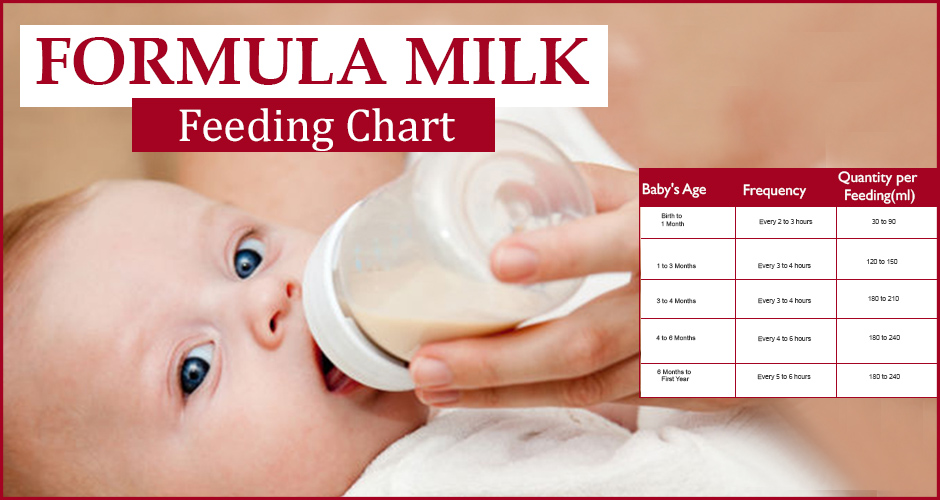3-4 month old babies need around 180 to 210 ml of formula milk per feeding in a duration of 24 hours. Babies require between 150 ml and 200 ml of formula per kg of body weight each day.
 Milk Recommendations For Infants Toddlers Baby Child Nutrition
Milk Recommendations For Infants Toddlers Baby Child Nutrition
However a baby might be given high-energy milk that provides 22 24 27 or more calories per ounce or 75 82 90 or 100 calories per 100ml.

Quantity of milk for babies. In this way the needs of the baby and the amount of breast milk they get are perfectly balances. Depending on the number of times your baby feeds every day you can determine the amount of milk that needs to be expressed per bottle per feed. 7 days old baby.
Video Signs my baby is drinking enough breastmilk. Plain water provides the hydration all of us need to live. At this stage your child only needs a minimum of 350ml and a maximum of 400ml of milk a day.
4 As growth slows breastfed babies continue to get bigger and heavier on about the same daily milk intake averaging about 25 ounces 750 mL per 24 hours. Milk provides calcium vitamin D protein vitamin A and zincall essential for healthy growth and development. Day 1 0 to 24 hours 7ml just over a teaspoon Day 2 24 to 48 hours 14ml just under 3 teaspoons Day 3 48 to 72 hours 38ml 13fl oz just over 2 tablespoons Day 4 72 to 96 hours 58ml 2fl oz just over 3 tablespoons Day 7 144 to 168 hours 65ml 22fl oz just over 35 tablespoons.
The general rule of thumb on formula milk measurements for babies is that it is measured as per their body weight. That is if a baby weighs 3 kg it will need between 450 ml and 600ml of formula per day. Does breast milk protect a baby from the flu.
If you see fit you can even wake your baby up in order to provide him with milk. Your babys age Amount of milk per feed. But if your child is consuming a lot of dairy at meals throughout the day you may need to offer less milk.
Solid food shouldnt take the place of milk as the main source of nutrients. However the intake in general could range from 450 to 1200ml per day. This can be breastmilk formula milk or cows milk or any other variety recommended by your doctor.
At one week old your baby has started to gain back the lost weight and needs 14 to 22 ounces of milk per day. The overwhelming majority of American babies are not exclusively breastfed for this period in 2005 under 12 of babies were breastfed exclusively for the first 6 months with over 60 of babies of 2 months of age being fed formula and approximately one in four breastfed infants having infant formula feeding within two days of birth. The stomach is the size of an apricot and can hold 15 to 2 ounces of milk.
Indeed babies should still drink about 4-6 ounces per feeding when theyre 4 months old. While guidelines suggest 600ml of milk per day for children between 4 and 8 years of age less if they are younger its important to realise that this doesnt refer to the amount of calcium a child needs in order to reach their recommended daily allowance RDI. The average intake of breast milk remains at around 25oz 750ml per day for babies aged between one to five months 2.
After the first day you can begin to supplement with baby formula as their demand increase but do not push them to take too much. Between the ages of 1-3 it is recommended that children consume around 350-400mls of milk or 3 servings of dairy foods daily. This is a rather misleading message so its easy to see how people can get confused.
On average babies weigh 6 - 9 pounds at birth and will need between 14 to 22 ounces of milk per day. Four to Six Months 4 to 6 Months. Below is a brief roundup of the main types of milk that might be offered at this stage.
When you start giving your baby solids his daily intake of formula milk is likely to gradually decrease to about 600ml Crawley and Westland 2013. At this age babies usually consume between 2 to 5 ounces of milk during each sitting. Some children however only choose to eat every 4 to 5 hours.
Younger babies with smaller tummies take less milk Breastfed babies milk intake doesnt increase from months 1 to 6 because their growth rate slows. Yes breast milk does protect your baby from flu along with a large number of other viral and bacterial infections. Children ages 12-24 months are advised to drink whole milk and children 2 and older nonfat skim or low-fat 1 milk.
By this time the baby could be drinking around 180 to 240 ml of formula per feeding in a day. Babies are great at knowing the amount of milk they require. Your body produces antibodies.
Standard calculations for estimating milk requirements are based on regular strength breastmilk or infant formula which provides approximately 20 calories per ounce or 68 calories per 100ml. Once your baby is fully established on solids hell need about 600ml of formula every day alongside a varied diet Crawley and Westland 2013 NHS 2012a. The average amount will be between 60 to 90 ml every feeding.
Kids Health states that 2-month-old babies typically eat six to eight bottles of 4 to 6 ounces a day and might need an additional 1 ounce of formula by the time they reach 3 months. After your baby is one year old she can move from drinking formula to full-fat cows milk. This should occur every 3 to 4 hours.